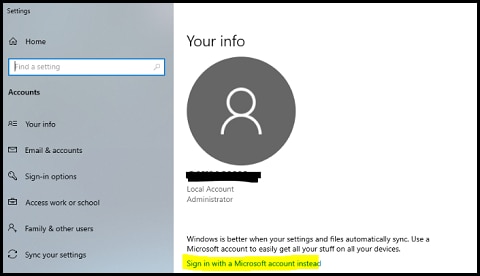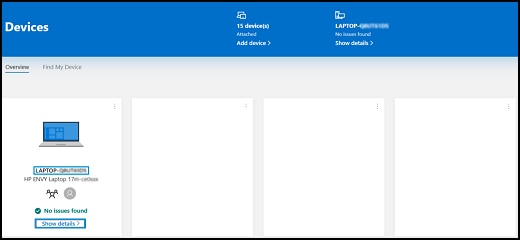Z7_3054ICK0KGTE30AQO5O3KA30N0
hp-concentra-wrapper-portlet
 Actions
Actions
HP PCs - Using BitLocker or Finding the Recovery Key (Windows x)
This document is for HP computers that support BitLocker Drive Encryption or Device Encryption.
Device encryption prevents unauthorized individuals from accessing your device and data. Your figurer might support BitLocker Drive Encryption (in English language) or Device Encryption (in English).
You can check whether your device supports standard BitLocker encryption or Device Encryption.
Be sure to relieve your recovery key, because information technology might be required later on certain actions, such as a BIOS update.
Data protection with BitLocker Drive Encryption
BitLocker Bulldoze Encryption is also known as standard BitLocker encryption.
BitLocker Drive Encryption is available on supported devices running the Windows 10 Pro, Windows 10 Enterprise, or Windows 10 Instruction operating systems.
note: BitLocker Bulldoze Encryption is not available on devices running the Windows 10 Home operating organisation.
If your device uses BitLocker Drive Encryption to encrypt your data, you must activate BitLocker.
During the activation process, you lot tin can select where to store the recovery key. This transmission recovery key backup process is initiated when BitLocker is turned on.
Data protection with Device Encryption
Device Encryption is a characteristic-limited version of BitLocker that encrypts the unabridged system. Device Encryption is also known equally BitLocker Device Encryption or BitLocker Automatic Device Encryption.
Device Encryption is available on supported devices running whatsoever Windows 10 operating organisation. It requires a TPM and Modern Standby support.
Windows automatically enables Device Encryption on devices that support Modern Standby (in English language). Microsoft offers Device Encryption support on a broad range of devices, including devices that run Windows 10 Home edition. Encounter Overview of BitLocker Device Encryption.
Device Encryption is enabled automatically when you either sign into your device with a Microsoft account or bring together with a corporate domain account.
The recovery key is uploaded to the Microsoft business relationship or the corporate domain automatically.
Enabling BitLocker Bulldoze Encryption or Device Encryption
Enabling BitLocker Drive Encryption
-
Sign in to Windows with an administrator account.
-
In Windows, search for and open Manage BitLocker.
-
Click Turn on BitLocker, and then follow any on-screen instructions.
-
When prompted, select an pick to dorsum upward your recovery key.
note: You lot tin back up the recovery cardinal after, if necessary. In Windows, search for and open Manage BitLocker, and then click Dorsum upwards your recovery central.

-
Follow the onscreen instructions for your selected backup method. The options might vary depending on your BitLocker type.
notation: Microsoft does not recommend printing recovery keys or saving them to a file. Instead, Microsoft recommends using an Agile Directory fill-in or a cloud-based fill-in. Cloud-based fill-in includes Azure Active Directory (Azure Advertizement) and your Microsoft business relationship.
-
Save to your Microsoft account: Save the recovery key to your Microsoft account, to exist accessed online.
-
Salve to your cloud domain account: Salvage the recovery key to your company's cloud domain.
-
Salve to a USB wink drive: Save the recovery cardinal to a removable USB flash drive.
-
Save to a file: Save the recovery key to a .txt file stored on your computer difficult drive.
-
Print the recovery central: Impress a copy of the recovery key and store it in a safety location.
-
After saving the recovery cardinal, follow the on-screen instructions to end the BitLocker Drive Encryption process.
Enabling Device Encryption
Device Encryption can be enabled during your initial computer setup or any fourth dimension after by signing in with your Microsoft account or by joining a domain.
Enabling Device Encryption during calculator setup using a Microsoft account
-
Follow the on-screen instructions to set up your estimator.
-
Afterward agreeing to the End-User License Agreement (EULA), you are prompted to add or create your Microsoft account. Enter the electronic mail, phone number, or Skype username associated with your Microsoft account and then click Side by side, or click Create account and follow the on-screen instructions.
-
Enter your password, and then click Next.
-
Follow the on-screen instuctions to complete your computer setup.
-
Afterwards your computer setup is complete, you can verify that Device Encryption is enabled. In Windows, search for an open Settings.
-
Select Update & Security, and then select Device encryption. Device encryption is on and encrypting all nowadays files and whatsoever files added to the organization.
note: In addition, if you search for an open File Explorer, a lock icon is displayed on the operating organisation drive.

Enabling Device Encryption after computer setup using a Microsoft account
-
Sign in to Windows with an administrator account.
-
In Windows, search for and open Settings, select Update & Security, so select Device encryption.
-
Click Sign in with a Microsoft business relationship instead. The Accounts folio opens.
note: If Device Encryption is enabled merely has been turned off, click Plow on.

-
On the Accounts page, click Sign in with a Microsoft account instead.

-
Enter the e-mail, phone number, or Skype username associated with your Microsoft account and and so click Next, or click Create business relationship and follow the on-screen instructions.
-
Enter your countersign, then click Next.
-
Follow the on-screen instructions to finish your account setup, and so sign in to your Microsoft account.
-
Later your calculator setup is complete, you tin can verify that Device Encryption is enabled. In Windows, search for an open Settings.
-
Select Update & Security, and so select Device encryption. Device encryption is on and encrypting all nowadays files and whatever files added to the organisation.
note: In addition, if you lot search for an open File Explorer, a lock icon is displayed on the operating organization drive.

Using the recovery key
Computers encrypted with BitLocker Drive Encryption or Device Encryption might crave the entry of a recovery key subsequently ane of the post-obit events:
-
BIOS update
-
A Microsoft Button Button reset
-
Disabling Secure Boot or Trusted Platform Module (TPM)
-
Hardware changes such as adding or removing video or network cards

Normally, y'all dorsum up your recovery key when BitLocker is enabled. If you are enabling BitLocker Drive Encryption, manually select where to store the recovery fundamental during the activation process. If yous are enabling Device Encryption and you log in to your computer using a Microsoft account, the encryption starts automatically and the recovery central is backed upwards to your Microsoft account.
Retrieve, and then enter the recovery cardinal to showtime continue using your computer again.
Retrieving the recovery central from your Microsoft account
When you sign in using a Microsoft account, Device Encryption starts automatically. If you use BitLocker Bulldoze Encryption, yous must have manually saved the recovery key to your Microsoft account to use this procedure. If there is a problem and y'all are unable to sign in, you must utilize the recovery central to sign in.
-
-
In the Microsoft account choice, click Sign in.
-
Follow the on-screen instructions to log in to your Microsoft business relationship.
-
If you lot have multiple computers, you can identify the correct key by matching the Device Name.

-
Your recovery central is the recovery key with a Device Name that matches the Recovery primal ID on the recovery prompt.
-
Blazon the recovery key into the Enter the recovery key... field in Windows, so click Go along.
-
Sign in with the Microsoft account yous use on the computer that requires a recovery key.

-
Click All Devices, locate the device proper noun that matches the figurer with the encryption issue, and so click Show details.

-
Click Manage, and then select Get BitLocker recovery keys to go the key.

-
Your recovery fundamental is the recovery cardinal with a Device Name that matches the Recovery key ID on the recovery prompt.
Other options to retrieve your recovery primal
Finding your recovery central depends on the method you used to back up the key. You tin use the following backup options as a guide to locate your recovery cardinal.
Utilize a cloud domain account
If your computer is continued to a domain, such as a school or work computer, your recovery might exist saved to your school or work's cloud domain. If you cannot locate your recovery fundamental, ask your system ambassador assist to observe your recovery central. Be sure to tell your ambassador your Recovery fundamental ID from the recovery prompt on the computer.
Use a USB flash drive
If you saved your BitLocker recovery key to a USB flash drive, insert the USB wink drive into a USB port on your computer and follow the on-screen instructions.
If your instructions for the recovery key exercise not brandish automatically, you might accept saved the recovery central as a text file. Insert the USB flash drive into a USB port on a dissimilar computer to open up the text file (.txt).
Open a local file
The key might be saved every bit a local text (.txt) file stored on a non-encrypted difficult drive on a dissimilar device. If the primal is stored on your encrypted drive, you cannot access information technology.
Utilize a printed copy of the central
You might have printed out the recovery fundamental when y'all set up up device encryption. Cheque the location where you store calculator-related information for a printout of your recovery key.
Utilise an Azure Agile Directory account
If yous always used a work or school email account to sign into an arrangement with an Azure Active Directory (Ad) account on your figurer, your computer recovery key might be saved in that system's Azure AD account associated with your email. Yous might be able to access your recovery key through that account, or yous might be able to ask a system administrator to detect your recovery key.
Admission some other Microsoft account
If in that location are multiple Microsoft accounts used on the same computer, such as when multiple users share one computer, sign in to some other account with administrator privileges to unlock the computer with the recovery key.
pattersonloppost.blogspot.com
Source: https://support.hp.com/hr-en/document/c06432394
![]() Actions
Actions 








0 Response to "Bitlocker Enter the Recovery Key to Get Going Again"
إرسال تعليق